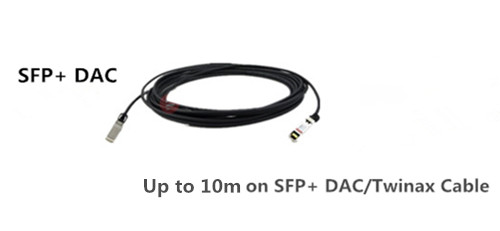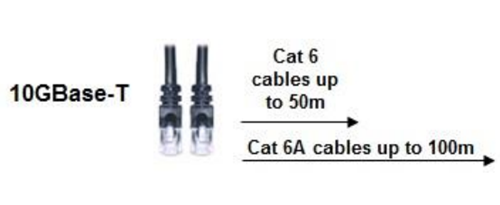Dramatic growth in data center has led to the increasing demand for higher-performance servers, storage and interconnects. As a result, people are seeing the expansion of higher speed Ethernet solutions, specifically 10 and 40 gigabit Ethernet. In particular to 10 gigabit Ethernet. IT managers are now faced with the challenge of selecting the appropriate 10-gigabit physical media—SFP+ or 10GBASE-T. From the following espects, let’s make a comparison of these two options so that you can select the solution that best fits your needs.
Power and Latency
Power is a very finite commodity in many environments, especially data centers. It is important to note that for every watt of power consumed, typically two additional watts of power are needed for cooling, to remove the heat generated. 10GBase-T PHY components today require 4 to 6 watts per port at each end. SFP+ PHY electronics, while driving DACs, use less power—typically less than 1 W per port.
Power is a very finite commodity in many environments, especially data centers. It is important to note that for every watt of power consumed, typically two additional watts of power are needed for cooling, to remove the heat generated. 10GBase-T PHY components today require 4 to 6 watts per port at each end. SFP+ PHY electronics, while driving DACs, use less power—typically less than 1 W per port.
With simpler electronics without block encoding, SFP+ also offers better latency—typically about 0.3 microseconds per link. 10GBASE-T latency is about 2.6 microseconds per link due to more complex encoding schemes within the equipment.
To sum up, lower power consumption and lower latency makes SFP+ well suited for large high-speed supercomputing applications where latency is a critical factor and where high port counts can add up to significant power savings
Comparing Distance
10GBASE-T can reach 100 meters using the latest Cat 6A or Cat 7 cables. The standard has been engineered to allow for patch panels and jumper cables as well. The MSA which defines direct attach cable specifies a maximum distance of 8.5 meters (about 28 feet). They are factory terminated and must be purchased in pre-determined lengths. SFP+ active optical cables (AOC) can support longer distances up to 100 meters, but at a much higher cost and with the same limitations as SFP+ DAC for point to point connections.
10GBASE-T can reach 100 meters using the latest Cat 6A or Cat 7 cables. The standard has been engineered to allow for patch panels and jumper cables as well. The MSA which defines direct attach cable specifies a maximum distance of 8.5 meters (about 28 feet). They are factory terminated and must be purchased in pre-determined lengths. SFP+ active optical cables (AOC) can support longer distances up to 100 meters, but at a much higher cost and with the same limitations as SFP+ DAC for point to point connections.


Cost and Interoperability
SFP+ DAC solutions available from switch vendors are often proprietary and cost more than category 6A patch cords from cabling vendors. With 10GBASE-T rapidly becoming the de factor LOM technology, the use of SFP+ can means an additional cost of adapters for the servers.
SFP+ DAC solutions available from switch vendors are often proprietary and cost more than category 6A patch cords from cabling vendors. With 10GBASE-T rapidly becoming the de factor LOM technology, the use of SFP+ can means an additional cost of adapters for the servers.
In addition, 10GBASE-T also has the advantage of being an interoperable, standards-based technology that uses the familiar RJ45 connector and provides backwards compatibility with legacy networks via autonegotiation. The ability to autonegotiate between 1 and 10 gigabit speeds allows 10GBASE-T server upgrades to occur on an evolutionary, as-needed basis. SFP+ solutions do not support autonegotiation and are limited with little or no backwards compatibility. Customers cannot just add SFP+ 10GbE to an existing RJ-45 1GbE infrastructure. New switches and new cables are required, which is a big chunk of change.
Which Technology Is Better?
In general, every designer should choose the technology that improves their overall design. The choice is not always transparent, but after reviewing the specifications, it will be clear which technology will yield the best results for your application.
In general, every designer should choose the technology that improves their overall design. The choice is not always transparent, but after reviewing the specifications, it will be clear which technology will yield the best results for your application.
10GBase-T is likely to be used by clients who value cost over latency and power. 10Gbase-T allows clients to use low cost copper CAT6/6A cables with RJ45 connections for distances up to 100m. But for clients wanting low latency and low power consumption, they will use Direct Attached Copper (DAC) SFP+ cables for in-rack cabling and distances up to 7 meters.
Conclusion
10GBase-T and SFP+ both have their merits and demerits. Both technologies should find an important place in the future of network design and best practices. Fiberstore, as a professional telecom manufactuerer, provides a complete range of compatible SFP+ transceivers, such as F5-UPG-SFP+-R, HP J9150A, X2-10GB-LRM, FTLX1471D3BCV, AXM763, etc.
10GBase-T and SFP+ both have their merits and demerits. Both technologies should find an important place in the future of network design and best practices. Fiberstore, as a professional telecom manufactuerer, provides a complete range of compatible SFP+ transceivers, such as F5-UPG-SFP+-R, HP J9150A, X2-10GB-LRM, FTLX1471D3BCV, AXM763, etc.
评论
发表评论